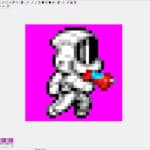Overview
This video is the second of a two-part series covering some useful tips to improve your workflow and solve some common problems when creating pixel art using GraphicsGale. In this video, you will learn how to use layers to develop overlays and effects for sprites and tiles. Layers are a powerful tool that can expand or enhance your assets without altering the base image.
Onion-skinning is an animation tool that allows you to preview the previous or next frame in a sequence, helping to better track changes in motion. To enable onion-skinning, you first need to enable transparency in your frames, but the process is as simple as editing your frame properties.
When you’ve completed an animation or a tileset and you want to export it into a compact format that saves you or your programmer from digging through a mass of separate files, a sprite or tile sheet is what you need. Using the Export function of GraphicsGale, we can output a combined sprite sheet with only a few clicks. In addition, a companion CSV file can contain useful data to help integrate your art into an application more quickly.
In addition to the default 1×1 pixel brush, GraphicsGale has a host of other brush types and patterns that can come in handy. We’ll quickly go through the list of what’s available and how they function.
Finally, for those times when your UI goes ‘askew’, we’ll talk about resetting the interface. A careless click and drag can move about the various panel dockers that make up the GraphicsGale interface. A trip to the Preferences options can set things right and get you back to work.
